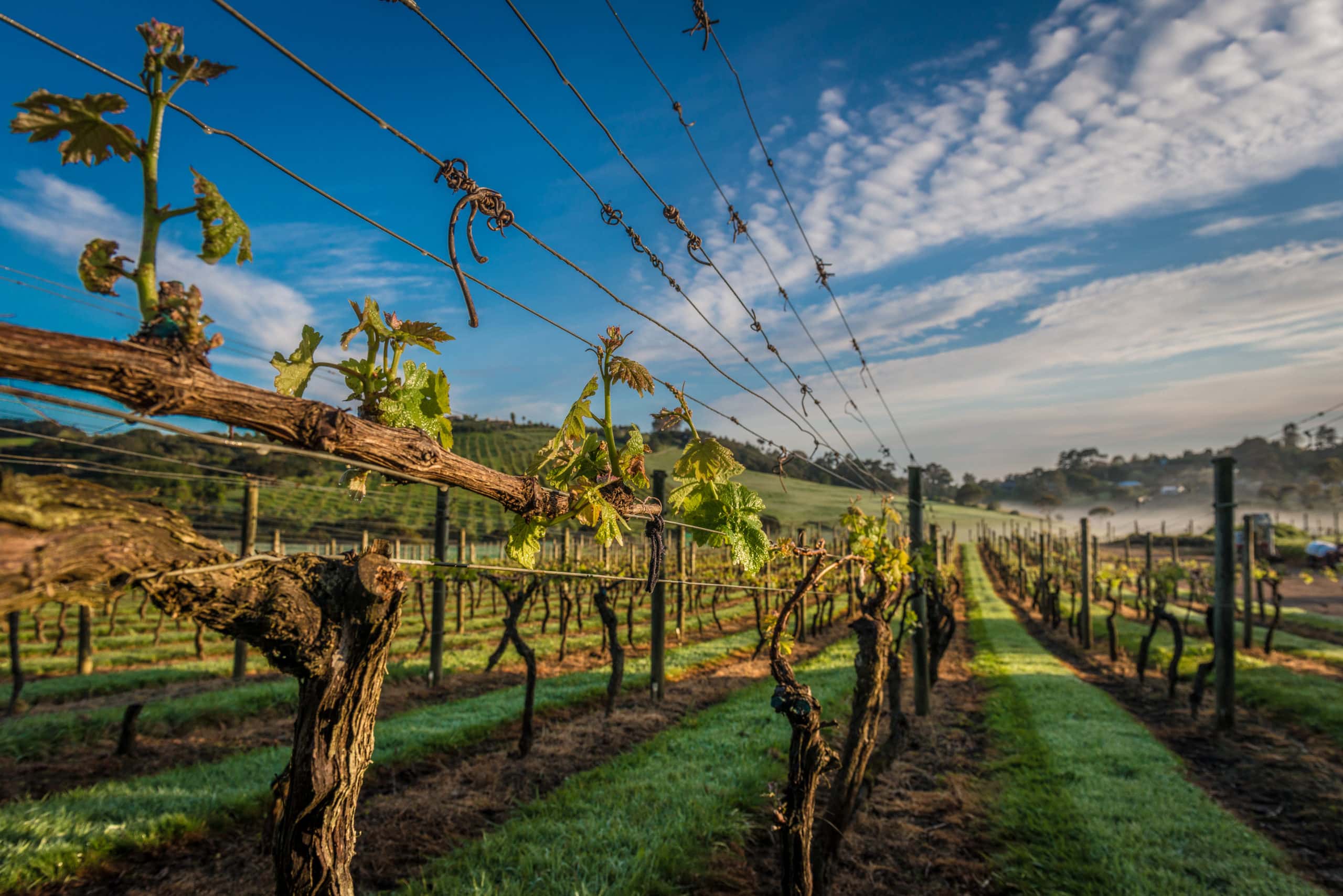VINEYARD ECOSYSTEMS PROGRAMME
Pruning wound protection – a case study
Protecting grapevines against trunk diseases can include a range of interventions in the vineyard, but one approach that’s gaining in popularity in New Zealand involves the use of pruning wound treatments, made either by hand (painting over the wound’s exposed surface) or via the application of fungicides with tractor-driven sprayers. According to recent research, there’s a good reason for the rapid adoption of this practice – using effective fungicides for pruning wound protection really works.
Optimising the management of grapevine trunk disease (GTD) has been a focus of New Zealand Winegrowers research for decades – most recently, as part of the extensive Vineyard Ecosystems Programme, managed by Bragato Research Institute.
Current investigations, led by Mark Sosnowski (South Australian Research and Development Institute – SARDI) and Dion Mundy (Plant & Food Research – PFR), build on their previous work, including a survey of almost 700 vineyard blocks in Hawke’s Bay and Marlborough, first conducted in 2013 and repeated in 2018.
In 2013, the incidence of infection from grapevine trunk disease pathogens ranged from 0–88% in selected NZ vineyards aged 4–33 years (with an average vine age of 12 years). Subsequent economic analysis showed that early adoption of preventative wound treatments could minimise the cost of trunk diseases and increase vine longevity.
Five years on, the Sosnowski-Mundy team re-surveyed the same vineyards (now with an average vine age of 17 years). Their reasons for revisiting the previous monitoring effort were to provide insight into the progression of GTD in New Zealand vineyards, including the influences of management practices. The project, which began in January 2017, also seeks to:
- Investigate the length of time that pruning wounds are susceptible to GTD pathogens.
- Optimise the timing of wound protection treatments.
- Understand how GTD pathogens are dispersed throughout the pruning season.
World-leading research
The researchers’ previous investigations also generated evidence to support label registration for selected fungicides for dual control of eutypa and botryosphaeria dieback – a world first.
Research into applications of fungicides with tractor-driven sprayers followed, first in Australia and then New Zealand (for a list of products currently available for control, refer to the latest edition of New Zealand Winegrowers’ Vineyard Spray Schedule).
It’s fair to say that these two countries are leading the world in wound protection research and, with little work conducted elsewhere, continuing this investigation is vital to the long-term management of GTD, says Mark Sosnowski, who has become a familiar presenter to NZ growers thanks to his many appearances at Grape Days and Romeo Bragato events.
Now, the latest annual report on GTD research (“NZW 16-102: Optimising management of grapevine trunk diseases for vineyard longevity”) provides a demonstration of wound protection in action.
Pruning wound protection at Delegat
As a case study on wound protection, a group of 102 Delegat blocks were selected, comprising Chardonnay, Merlot, Sauvignon Blanc, and Pinot Noir. The blocks, located in both Marlborough and Hawke’s Bay, have had a well-documented wound protection management in place since 2006, prompted by the potential economic benefits achieved from vine longevity.
In all of these blocks, large wounds (>25 mm) were consistently hand painted with registered fungicides following pruning up until 2012. Then, from 2013, all wounds, regardless of size, were protected each year with hand-painted applications. A selected fungicide is ideally applied on the day of pruning but must be applied within 72 hours and definitely before rainfall.
According to Robert Trought, company viticulturist at Delegat, rainfall and sap flow from pruning later in the season create some challenges for application, but the effort is definitely worthwhile. “You need to look past the immediate cost and look to the long-term benefits,” he adds. “It is your asset you are protecting. If you have young vines, start from day one.”
Figure 1 shows scatter plots of the incidence of dieback infection in 2018 for all vines (top), and for the selected 102 Delegat blocks (bottom). The selected blocks were aged between 9 and 21 years in 2018, so vines under 12 years of age have had wound protection since they were planted, whereas the oldest vines have had wound protection since 10 years of age. Across all blocks, the maximum incidence of dieback infection increased with vine age (from 20% in 10-year old vines to 80% in 20-year old vines), whereas the subset of Delegat blocks under active wound management only reached a maximum of 20% incidence of dieback infection over the same range of vine ages.

Figure 1. Scatter plots of the incidence of dieback in all blocks surveyed in 2018 (top) and the 102 selected Delegat blocks (bottom) with active pruning wound protection in place since 2006. Blue lines indicate the maximum dieback incidence for vines aged between 10 and 20 years of age.
“Delegat’s decision to follow best practice and commit to an extensive programme of pruning wound protection over a decade ago is paying off, reducing the negative impact of trunk disease on vineyard longevity,” says Sosnowski.
Where to from here?
In the time remaining to the GTD project, Sosnowski plans to confirm the curative and preventative properties of fungicides registered for use in New Zealand. The goal is to inform recommendations to maximise the period of wound protection from a single application.
The long-term benefits could be substantial, according to Hoskins, who points to previous economic modelling developed by Mark Sosnowski and Greg McCarthy and reported in the June/July 2017 Research Supplement of New Zealand Winegrower magazine.
“If pruning wound treatments become a routine practice in New Zealand vineyards,” he adds, “the modelling indicates there’s potential to save the industry $20 million each year.”
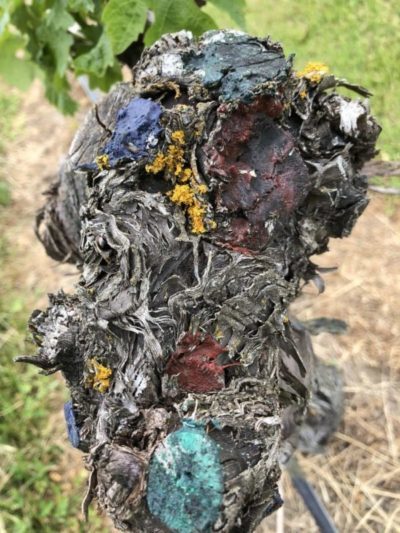
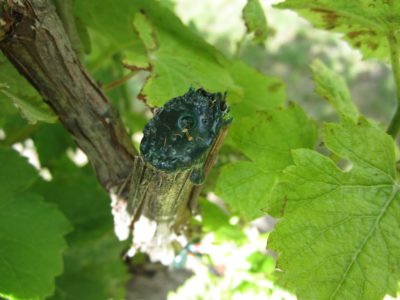
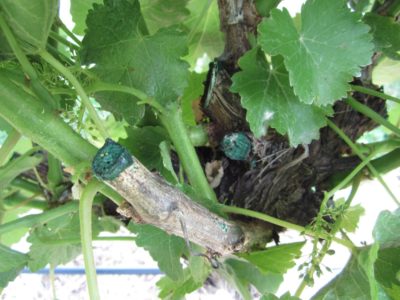
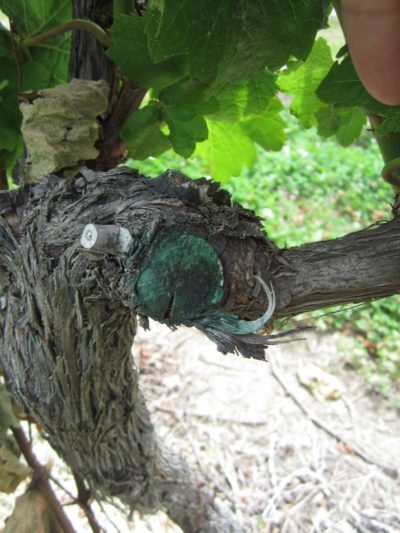
Figure 2: Examples of proactive management activities using a range of pruning wound paints.
This article first appeared in the April/May 2020 issue of the New Zealand Winegrower Magazine.


